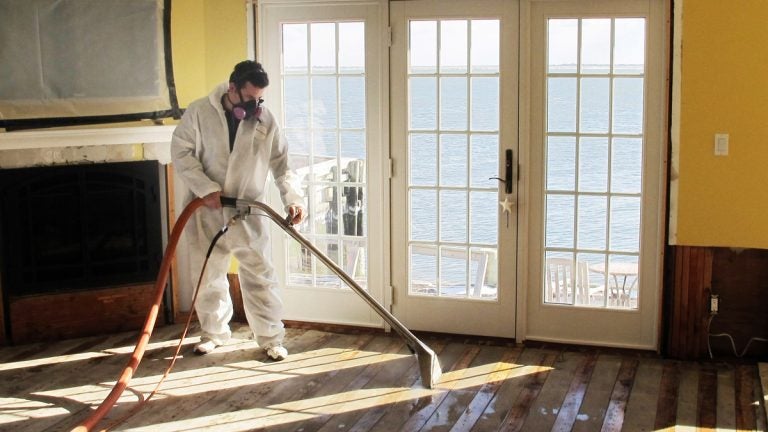One year after Sandy, hospital still screening for mold related health problems

Victor Pena of Flag Enterprises steam-cleans a floor to remove mold. (AP Photo/Frank Eltman, File)
Among Hurricane Sandy’s longest-lasting and more insidious legacies is the mold that has stained the walls of once-inundated buildings.
But for Deborah Heart and Lung Center the damage is more than cosmetic. It’s helping residents detect whether they have mold-related health problems.
Deborah, a hospital in the Browns Mills section of Pemberton Township, has been conducting screenings for respiratory conditions that may be linked to mold in Sandy-affected areas since May.
The hospital’s medical experts “knew residents would unknowingly be exposed to mold, especially the older populations and those who live down in Ocean County,” as well as first responders, volunteers, and contractors, according to Joseph Manni, hospital vice president and chief operating officer.
Deborah successfully applied for a $650,000 grant from the New York-based Robin Hood Foundation, which has been a major funder of Sandy relief efforts, to launch its Respiratory Evaluation of Sandy Program (RESP).
The hospital then met with community, municipal, and charity representatives to organize a series of screenings, reaching 885 residents at 13 events held through early November.
Joseph Manni, vice president and chief operating officer of Deborah Heart and Lung Center.”We elicited their help to set up the screenings and point us in the direction of the individuals and the communities that were hardest hit,” Manni said.
Roughly 130 people — 15 percent of participants — have tested positive for some respiratory problem, including having a low amount of oxygen in their blood or not being able to get enough air in their lungs when they breathe. Those residents have been referred to their primary-care providers or specialists.
Dr. Andrew Martin, Deborah’s pulmonary medicine chairman, said the storm led some residents to be concerned about an irritation in their lungs caused by the persistently wet environment. He said the screenings have uncovered existing respiratory conditions that may have been aggravated by the storm, such as allergies or asthma.
Martin added that the screenings have helped reassure people who thought they might have a lung problem caused by mold.
“People are worried very often about getting mold infections, which is exceedingly rare,” Martin said, noting that residents must have extremely compromised immune systems to develop mold infections. More commonly, mold acts like pollen in aggravating allergies.
Manni noted that it’s frequently impossible to know a year after the storm whether Sandy caused a particular respiratory condition. “These are individuals that may not have otherwise realized that they had a respiratory issue going on,” he said.
Anne Marie Friscia, Union Beach municipal clerk, also said the screenings are reassuring, even for residents who are concerned about mold in a neighbor’s house — which generally won’t cause health problems.
“People do have these concerns,” Friscia said, adding that the municipality wasn’t informed of the results of a screening held there in October.
Debbi Winogracki, spokeswoman for Toms River Township, noted that local residents have been sensitive about the long-term respiratory effects of disasters since the September 11, 2001, attacks.
“We had the mold screenings just because we didn’t know anything. I didn’t know what we were going to find,” Winogracki said. The screenings in Toms River didn’t reveal a problem, but Winogracki said the township will likely schedule more screenings — possibly years in the future — to make sure a problem doesn’t develop.
Bridget Holmes, case management coordinator for the Ocean County Long Term Recovery Group, said residents are still finding mold in their homes a year after the storm.
“What’s been so interesting is we’re finding a number of people who didn’t consider themselves to be storm-impacted until now, until the mold has had a chance to grow in the home, sometimes unbeknownst to the homeowner or renter,” Holmes said.
She explained that the storm sometimes causes roof damage that isn’t immediately apparent, leading to cracks that seeped water for months. Her organization is supported by a wide range of charitable organizations and serves as a point of contact for people seeking Sandy recovery assistance.
Holmes said the screenings have drawn both residents who weren’t aware of a problem and those who immediately removed mold-covered drywall after the storm.
She said that the mold screenings are an example of something she’s heard about from survivors of other disasters, related to the difference between immediate disaster “relief,” such as food and shelter, and longer-term “recovery,” such as dealing with longer-term health consequences.
Survivors say that for every month that a community needs disaster relief, it will require a year of assistance to meet recovery needs.
Since it took more than 10 months to help residents move back into their homes, it will take that much longer to deal with the long-term effects from Sandy.
“We’re looking at a decade of recovery — if those homes aren’t being worked on currently because the funding isn’t there yet or the project is awaiting grant approval, then that mold can be growing unchecked,” Holmes said.
Holmes credits Deborah for its work, noting that the hospital helped screen residents at Sandy anniversary events, turning an opportunity to remember the storm into a chance to receive services.
___________________________________________________________
NJ Spotlight, an independent online news service on issues critical to New Jersey, makes its in-depth reporting available to NewsWorks.
WHYY is your source for fact-based, in-depth journalism and information. As a nonprofit organization, we rely on financial support from readers like you. Please give today.




